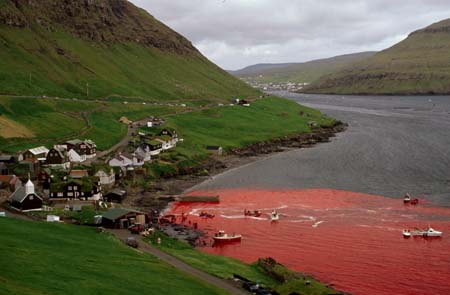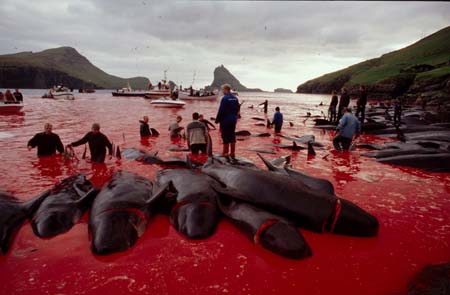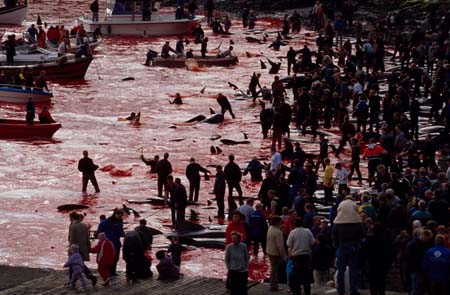
|
|
|
What's IotD? The interesting, amazing, or mind-boggling images of our days. |
|
IotD Stuff |
|
Permalink Latest Image |
|
|
|
Some folks who have noticed IotD
Neatorama |
|
Common image haunts
Astro Pic of the Day |
|
Advertising |
12/27/2005: Grindadráp whale kill

via Neatorama. The Scandinavian island nation of the Faroe Islands is home to this phenomenon I had never seen before: the Grindadrap whale kill. From the Wikipedia entry:
Around one thousand Long-finned Pilot Whales are harvested as a healthy, free range and organic food source in the annual whale drive (or "grind") by Faroese fishermen each year. This controversial event is also known as the Grindadráp. The drive works by surrounding the whales with a wide semi-circle of boats and slowly coaxing (or driving) them into a bay and then onto beach.

this gallery is the source of these shots, which are alarming to say the least. But it's a deep cultural artifact: the kill has been happening since at least the tenth century.

Kitsune Tuesday Dec 27 03:15 PM
| Those that remain unbeached have historically been stabbed in the blubber with a sharp hook, called a gaff, and then pulled to the shore. Responding to allegations of cruelty, the whalers have begun using blunt gaffs and, instead of stabbing the whale, putting the hook inside the blow-hole of the whale. |
capnhowdy Tuesday Dec 27 05:07 PM
somehow I feel like it is more the chase and kill that keeps this tradition alive rather than the abundance of "healthy, free range and organic" food source. Their own doctors tell them not to eat it more than twice a month for health reasons.
Oh, well.... its their little thingie. Let 'em have at it.
Elspode Tuesday Dec 27 09:48 PM
I'm sorry, but this has to be asked...what do they do with the whale peni?
xoxoxoBruce Wednesday Dec 28 01:31 AM
Like OJ, I don't approve....but I understand. 
beavis Wednesday Dec 28 03:33 AM
|
Originally Posted by Elspode
I'm sorry, but this has to be asked...what do they do with the whale peni?
|

Jealousy Wednesday Dec 28 05:35 AM
I've seen something like this on tv a while back, with the water turning blood red. It's just too disturbing. It had to do with dolphin slaughter in Japan's seas.
http://www.advocatesforanimals.org.u.../dolphins.html
And my apologies if I'm not supposed to post pics/links in these topics.
Griff Wednesday Dec 28 08:28 AM
Wait a minute, you're saying that these white people have a traditional culture? 
Smart marketing with the organojive.
chrisinhouston Wednesday Dec 28 09:56 AM
What would we rather see, this or a row of western style fast food shops on the main square? Meat is meat and from what I read it is processed and shared in an age old tradition, and in this climate protien from animals is about the only way to go; soybean products wouldn't suffice I think. If anyone thinks a slaugther house is anymore humane read "Fast Food Nation."
*************************
From http://www.whaling.fo/thepilot.htm#Killingthewhales
Distribution of a catch
The catch is divided among those taking part in the drive and the local residents of the whaling bays and districts in accordance with a complex, traditional community sharing system. The division of the catch is administered by the relevant district sheriff. The catch is divided into shares known in Faroese as a skinn, which is a age-old measurement value that derives from agricultural practices. One skinn is roughly equivalent to 34 kilos of blubber 38 kilos of meat. Whales in a catch are numbered and their value in skinn is marked in roman numerals.
When the calculation of the shares is complete, recipients receive notice of the number of the whale from which their share is to be taken, and the amount of skinn to which they are entitled. Together with others who have a share of the same whale, they butcher their share from the carcass and take their meat and blubber home themselves. This must be done as quickly as possible after the shares have been announced to ensure that the catch is properly divided and to avoid spoilage and waste. There is no industrial processing of any whale catch, and the local municipality where the catch takes place is responsible for clearing all remains within 24 hours of the division of the catch.
In most districts it is also customary to allot a share to the local hospitals and other institutions such as nursing homes and day-care centres. In a few of the bigger villages and towns, a small amount taken from the private shares is sold to the local food stores. The maximum retail price is regulated by governmental order and is about half the price of other meats such as beef or lamb.
Storage and preparation
The meat and blubber is stored, prepared and eaten in a variety of ways. When fresh, the meat is boiled or served as steaks, with blubber and potatoes. The meat and blubber can be kept in the freezer, or preserved in the traditional way by salting or outdoor wind-drying. Thin slivers of the blubber are also a popular accompaniment to dried fish.
wolf Wednesday Dec 28 10:21 AM
|
Originally Posted by Jealousy
I've seen something like this on tv a while back, with the water turning blood red. It's just too disturbing. It had to do with dolphin slaughter in Japan's seas.
http://www.advocatesforanimals.org.u.../dolphins.html And my apologies if I'm not supposed to post pics/links in these topics. |
Emrikol Wednesday Dec 28 03:02 PM
Once again, because I've seen more or less every IOTD (been around since damn near the beginning lurking), I bring you one from the archives (the dolphine one at least).
<a href="http://cellar.org/iotd.php?threadid=4262"><img src="http://cellar.org/2003/japandolphinkill.jpg"></a>
That's what I'm here for!
xoxoxoBruce Wednesday Dec 28 04:47 PM
|
Your reply here?
The Cellar Image of the Day is just a section of a larger web community: a bunch of interesting folks talking about everything. Add your two cents to IotD by joining the Cellar. |
